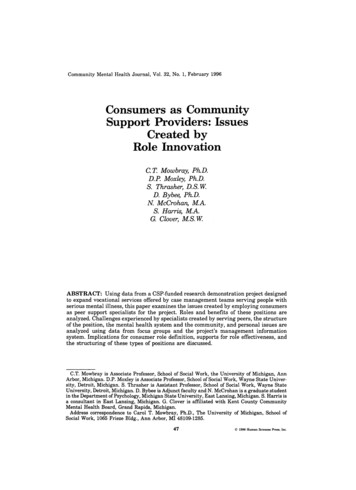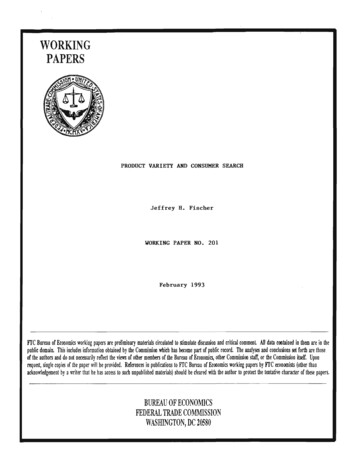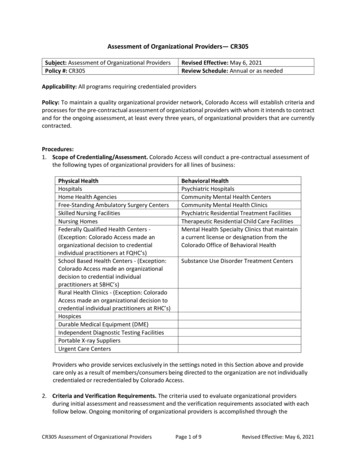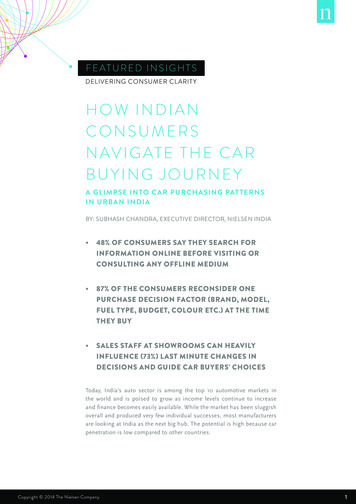
Transcription
Community Mental Health Journal, Vol. 32, No. 1, February 1996Consumers as CommunitySupport Providers: IssuesCreated byRole InnovationC. T Mowbray, Ph.D.D.P. Moxley, Ph.D.S. Thrasher, D.S. W.D. Bybe Ph.D.N. McCrohan, M.A.S. Harris, M.A.G. Clover, M.S. W.ABSTRACT: Using data from a CSP-funded research demonstration project designedto expand vocational services offered by case management teams serving people withserious mental illness, this paper examines the issues created by employing consumersas peer support specialists for the project. Roles and benefits of these positions areanalyzed. Challenges experienced by specialists created by serving peers, the structureof the position, the mental health system and the community, and personal issues areanalyzed using data from focus groups and the project's management informationsystem. Implications for consumer rote definition, supports for role effectiveness, andthe structuring of these types of positions are discussed.C.T. Mowbray is Associate Professor, School of Social Work, the University of Michigan, AnnArbor, Michigan. D.P. Moxley is Associate Professor, School of Social Work, Wayne State University, Detroit, Michigan. S. Thrasher is Assistant Professor, School of Social Work, Wayne StateUniversity, Detroit, Michigan. D. Bybee is Adjunct faculty and N. McCrohan is a graduate studentin the Department of Psychology,Michigan State University, East Lansing, Michigan. S. Harris isa consultant in East Lansing, Michigan. G. Clover is affiliated with Kent County CommunityMental Health Board, Grand Rapids, Michigan.Address correspondence to Carol T. Mowbray, Ph.D., The University of Michigan, School ofSocial Work, 1065 Frieze Bldg., Ann Arbor, MI 48109-1285.47 1996 Human Sciences Pre , Inc.
48Community Mental Health JournalINTROD UCTIONTraining and employment options are increasingly available to peoplewith psychiatric disabilities. In fact, funding through the federal Community Support Program (CSP) and other state and local sources hasestablished a number of programs where individuals work in mentalhealth systems in which they are or have been service recipients. Arecent survey of nearly 400 agencies which offer supported housing topersons with severe mental illness reported that 38% employed mentalhealth consumers as paid staff (Besio & Mahler, 1993). Reports onefforts to employ consumers are now emerging in the literature(Mowbray, Chamberlain, Jennings & Reid, 1988; Mowbray, Wetlwood& Chamberlain, 1988; Howie the Harp, 1990; Cook, Jonikas & Solomon, 1991; Stoneking, Greenfield, Sundby & Boltz, 1991; Simon,1992; Lysaker, Bell, Milstein, Bryson, Shestopal & Goulet, 1993;Manos, 1993). Consumer jobs have included peer job coaches, casemanager extenders, staff for drop-in centers, outreach workers, housingassistants, and many more. Besio and Mahler (1993) report salariesranging from 3.35 to 11.00 an hour.The involvement of consumers as mental health service providers hasbeen galvanized by a growing consumer movement, expansion of disability rights, and the legitimization of self-help and peer support.Reasons cited for consumer employment are multiple. First, consistentwith a rehabilitation philosophy, productive and important work ismade available and accessible to consumers (NIDRR, 1992). Meaningful work contributes to increased self-esteem, acquisition of specificwork skills, and perhaps career choices. Second, inclusion of consumersas mental health workers can increase the sensitivity of programs andservices about recipients. That is, consumer employees are capable ofbetter understanding clients' problems and their solutions, are betterable to develop trust and rapport with clients, and better promoteempowerment (Segal, Silverman & Temkin, 1993). Third, they canserve as effective role models for clients, and fourth, the inclusion ofconsumers is an expression of affirmative action and consistent withcontemporary civil and disability rights policies.While reports are few, it appears that considerable complexity andresource requirements may be involved in establishing consumer employee positions. Additionally, these employees face stressors whichmay limit this vocational option. For example, confidentiality or havinghad a prior relationship with an assigned peer have been cited asproblems (Besio & Mahler, 1993) as well as clients who test" the
C.T. Mowbray, Ph.D., et al.49authority of their consumer-worker (Cook et al., 1991). According tosome reports, consumer workers may suffer resentment or distrust fromnon-consumer staff fearing job displacement (Besio & Mahler, 1993;Manos, 1993), experience problems with role definitions and boundaryissues (Stoneking et al., 1991; NIDRR, 1992; Simon, 1992), or havedifficulties relating personally to other workers (Lysaker et al., 1993);although other literature has endorsed consumer employees as beingmore able to establish friendships with assigned clients (Engstrom,Brooks, Jonikas, Cook & Witheridge, 1991).Most published reports, however, provide only brief descriptions oftheir programs. Little information is available on the specific challenges which consumer employees face or how these have been resolved. In contrast, this report provides operational details onconsumer-employment and discusses its challenges. The program to bedescribed successfully employed consumers as peer support specialistswithin a CSP-funded research demonstration project designed to increase vocational opportunities to clients already receiving case management services (Mowbray, Rusilowski-Clover, Arnold, Allen et al.,1994). Using data from the program's management information system,and from two focus group sessions held in the developing and fullyoperational stages of the project, we describe how consumer employeeswere involved in the rehabilitation team, the vocational services theseworkers provided, and the benefits and challenges they experiencedpersonally, in interaction with the people to whom they provided support, and in the context of the mental health system.BACKGROUNDDescription of Project and ParticipantsProject WINS (Work Incentives and Needs Study) was funded as athree-year research demonstration project by the Center for MentalHealth Services, SAMHSA. Its purpose was tt add resources to expandthe vocational focus of seven existing case management teams (servingabout 800 clients) in a large, suburban, community mental healthservice system located in Kent County, Michigan (See Mowbray et al.,1994). The principles guiding WINS' operations emphasized theChoose-Get-Keep mode of vocational rehabilitation (Farkas & Anthony,1989) self-determination (Moxley & Freddolino, 1990), and zero exclusion, with eligibility based primarily on clients' self-selection ratherthan staff determination of work potential (Farkas & Anthony, 1989).
50Community Mental Health J o u r n a lDemographically, clients eligible for WINS services were in theirmid-thirties (median 36); the majority were white (80%) and over halfwere male (60.4%). Most graduated from high school, although educational levels ranged widely (four to 18). Functionally, clients fit adefinition of chronic mental illness widely accepted by rehabilitationand community support models of service delivery (Lawn & Myerson,1993). The predominant diagnosis was schizophrenia (41.6%), followedby affective disorders (20.6%). Most participants were experiencingmoderate symptoms and functioning with some difficulty and nearly allwere currently taking psychotropic medication (See Mowbray, Bybee,Harris, & McCrohan (1995) for more details.). During the 18 monthsbetween February, 1992 and July, 1993, 263 individuals were enrolledin Project WINS.The major component of WINS' operations were the services of fiveVocational Specialists (VS's)-professionals assigned to the case management teams, who provided direct services to a rotating caseload ofabout 25 clients each, along with case consultation and overall information about vocational issues to case managers from the teams.Consumer EmployeesClients could also elect to receive services from Peer Support Specialists(PSS's)-consumers who worked with a VS as a case manager extender.The PSS provided services to assigned individuals as negotiated intheir WINS intervention plan; for instance, helping clients to prepareresumes, set up bank accounts, acquire clothing for interviews or work,or learn the bus system. PSS's were also responsible for facilitating JobSupport Groups, producing a newsletter, and carrying out other informational activities for WINS.PSS's were referred by their case managers, interviewed by the WINSdirector, and hired if there was a mutual decision that the position wasappropriate for them. Three weeks' preservice training was providedbefore they started working with clients, focusing on conflict resolution,stress management, self-help principles, and operational issues. PSS'ssalaries ranged from five to seven dollars an hour, with employmentvarying from a few hours up to 30 per week, depending on availability,desire, and financial need. The compensation was based on face-to-faceor telephone contacts with peers, or scheduled activities in the agency.Project WINS originally intended to hire consumers as job coachesbut once implementation began it was obvious that many participantshad the skills to do their jobs. Rather, assistance and support were
C.T. Mowbray, Ph.D., et al.51n e e d e d a r o u n d g e t t i n g a n d k e e p i n g jobs. T h e PSS role, t h e r e f o r e ,evolved to e n c o m p a s s a wide r a n g e of c o m m u n i t y s u p p o r t activities.Characteristics of PSS'sOver 24 m o n t h s of project operations, 19 PSS's completed t r a i n i n g a n dw o r k e d on t h e project: 11 m a l e s a n d 8 females, a v e r a g e age of 34.8 years.Two were A f r i c a n - A m e r i c a n ; one w a s Hispanic; t h e r e m a i n d e r w e r e nonminorities. The a v e r a g e e d u c a t i o n a l level of PSS's w a s 13.5 y e a r s (range11-16). PSS's experiences w i t h t h e m e n t a l h e a l t h s y s t e m varied: of t h o s efor w h i c h d a t a were a v a i l a b l e (n 9), all h a d one or m o r e p s y c h i a t r i c hospitalizations; m o s t h a d m o r e t h a n one ( r a n g e 1-7). L e n g t h of t h e s e hospitalizations v a r i e d f r o m two to 314 days, w i t h a m e d i a n of 11 days. (Longerh o s p i t a l i z a t i o n s h a d occurred 8 or m o r e y e a r s previously.) H o s p i t a l i z a t i o nd a t e s r a n g e d f r o m 1982 up to t h e p r e s e n t (including some w h i c h occurredw h i l e b e i n g PSS's). On a v e r a g e , PSS's h a d b e e n c o m m u n i t y m e n t a l h e a l t hclients for 6.7 y e a r s (range 1-13).METHODManagement Information System DataService Activity Logs were submitted weekly by all direct service staff (vocationalspecialists and peer support specialists) to the agency's Information System from 2/92through 7/93. Logs provided daily records of the amount of time each staff person spentin specific activities with identified clients, as well as work time not associated withindividual clients (meetings, supervision, training, paperwork, etc.).Focus Group DataAll PSS's who had completed training since the beginning of the project were invited toattend a focus group session after 15 months of operations. A year later, when theproject was fully operational, all currently employed PSS's were invited to a secondfocus group. All attende s were compensated for their time. Of the eleven individualsattending the first session, about half were then employed as PSS's; the others wereinvolved with employment, school, and/or training. All six attending the second focusgroup were working as PSS's. For both meetings, focus group participants were givencopies of the focus group questions in advance and told that the purpose of the sessionwas to get a better idea of how the project was operating, so that improvements could bemade. Individuals were assured of the confidentiality of their individual responses andthat they could review the focus group summary. All participants agreed to taping thesession. The facilitator and one other project staff attending took notes during thesession. The tapes were reviewed by consultants external to the project and consensuswas reached on the results summarized below.
Community Mental Health Journal52RES UL TSQuantitative Summary of PSS WorkTen PSS's were employed over the 18-month period for which recordswere available. Of the 263 persons served by WINS during this timeperiod, 117 or 44% received some direct service from a PSS. Those notelecting to work with a PSS cited the adequacy of their existing supportsystems or felt unclear about how a peer could provide vocationalassistance. Ninety-five of the 117 who had contact with a PSS receivedsubstantial service (at least 1 hour of direct contact). Table 1 summarizes data from the m a n a g e m e n t information system on PSS employment and the services provided to clients. Typically, between 5 and ian Min.ProvidedMax.TotalPossiblePSS Employment Data# PSS's working/month# mos. employed# hrs. worked/month% hrs. direct client contact% hrs. indirect service: job dev.,marketing, activs, on behalf of clients% h r s . - p e e r support groups% hrs.-meetings% hrs.-paperwork# supervisory 01174.715151133-12.5220-321181018-PSS Service ProvidedTotal # clients assigned to all PSS's (permo.)Average caseload (per PSS/mo.)Total # clients served per PSS (over 18mos.)Total # served per PSS, w/subst, cont.(over 18 mos.)aD u r a t i o n of service contact (in mos.) I n t e n s i t y of service contact a (perclient/mo.), i n hrs.35afor cases receiving substantial PSS service (i.e., at least one hour of direct contact)
C.T. Mowbray, Ph.D., et al.53PSS's were employed per month, and they worked about 7 hours perweek, for somewhat more than a year's duration. Five of the PSS'sworked continuously, with no breaks in direct service of a month ormore; the other five each had an intervening break lasting one to fivemonths (median 3.5). About half the PSS time was equally dividedbetween direct client contact and running support groups. The activities of indirect services, paperwork and meetings each used aboutanother 10-15% of time. The percent of time PSS's typically spent ondirect service was comparable to that for the vocational specialists(VS's). Supervision of PSS's was provided by the VS's and over the totalproject period required each to spend about 10 hours per month perPSS. However, supervision hours declined steadily over time (21.3hours per month average during the first quarter of the 18-monthperiod to 7.9 during the last quarter). This decline was not related tofluctuation in caseload size or PSS workload and appeared to be attributable to the passage of time, improvements in VS staff experience, andperceived or actual PSS expertise. (Changes in reporting practices mayalso be reflected.) Efficiency in supervision was also noted over time,with the ratio of direct client contact hours provided by PSS's per hourof supervision increasing steadily (from 2.2 in the first month to 12.4 inthe final month, median 6.1).The PSS staff worked with about 30 clients per month. The usualcaseload carried by a PSS was about 5 clients. Over the course of theiremployment, a PSS had typically served 15 clients. Generally, PSS'swho worked the most months served the greatest number (Pearson'sr .68). The usual service duration was 3 months per client and intensity was 2 hours per month of direct contact. However, these medianvalues belie the extreme variability in the data. For example, someclients received up to 10 hours per month of direct contact. IndividualPSS's monthly caseloads also varied widely-serving as few as one ortwo clients in some months and more than 10 in others. Similarly,variation in the number of hours PSS's worked per month was also high(10 or fewer hours in some months and more than 40 in others; medianinterquartile range of 20 hours).Focus Group ResultsThe focus group sessions provided an elaboration of the PSS role as wellas an identification of challenges presented to PSS's personally, bytheir role, by the CMH system, and by the structure of the PSS positionitself.
54Community Mental Health JournalRoles and Benefits of Peer Support Specialists. PSS's described thecomplexity of their job role: it was like being a friend, but differentbecause you were expected to help, to educate, and to provide leadership. Several felt that their most important function was to encourageclients (reinforcing past job accomplishments, developing interests, suggesting alternatives, and/or facilitating self-determination). Othersmentioned specific activities like counseling on personal hygiene, training on how to use public transportation, helping someone find a job, jobsite assessment, or conducting group sessions (e.g., resume writing).Some mentioned the importance of trying to change attitudes about thevocational abilities of individuals who are mentally i l l - t h o s e of employers and mental health professionals. Through their formal involvement in the mental health system, PSS's facilitated communication of aconsumer perspective to improve services. They believed the PSS roleunderscored the mental health system's commitment to consumerismand its willingness to take consumers seriously.There was general agreement on the value of relating to the assignedpeer (having a common bond, building trust, show people we lovethem") and of role modeling. At the second focus group, PSS's especiallystressed the importance of having a structure with clients, but remaining flexible within it; such as, setting regular appointments and keeping one's commitment, but accommodating disruptions and discussingtheir circumstances.The PSS's were highly positive about the benefits of their service: Mentally ill people feel alienated from the world. You need someone totalk to and be around with who is like you." They described severalpositive outcomes in clients' job successes-cashier, cook, factoryworker, hi-lo truck driver. PSS's were also sensitive to important psychosocial benefits which can accompany successful employment, suchas autonomy, confidence, and other associated rehabilitation outcomes,i.e., getting out of a negative living situation.Beside the benefits that recipients accrued from working with consumer employees, the PSS's also focused on the benefits they personallyexperienced from their roles. Tve seen my peers grow and I've grownwith them. It's been a sharing thing and really rewarding to me."Growth came about from being sensitive to the emotional states ofclients, fulfilling commitments, acknowledging mistakes, and learningfrom them. They also described developing specific skills and talents(e.g., 'I found I could talk in front of groups-not a trait I thought Ihad"), improving communication abilities CI found I'm getting moreinformation by getting feelings out t h a n letting them stay inside me"),
C.T. Mowbray, Ph.D., et al.55and increasing confidence CI felt it was an honor [being employed as aPSS]-mentat health workers treated me as an equal"). A lot of thesechanges occurred because of the unspoken respect they sensed fromother clients ("People respect your w i s d o m - r e a l rewarding") as well asthe positive comments they received from professionals. Finally, manyPSS's expressed the feelings of pride they experienced when one of theirpeers reached a vocational goal CShe was able to develop her ownindependency thinking").Challenges Involved in Serving Peers. Dealing with the behaviors ofthe clients they worked with were the most frequently mentionedchallenges, especially at the first focus group session. Particularlyproblematic were clients who were seen as "unmotivated": showing uplate or not at all for appointments; saying they changed their mindsabout working, etc. Such behavior was frustrating because it caused thePSS's to waste their own time and lose compensation and also becauseof the implication that the PSS contact (and possibly the PSS him/herself) was not valued by the client. Similar complaints are oftenvoiced by non-consumer mental health staff. Another set of problemsrevolved around clients' continued use of drugs and alcohol. PSS'sreported feeling personally let down in several cases when clients failedto maintain sobriety and consequently lost employment and all thegains that they had worked on so hard together CIt was my biggestdisappointment").At the second focus group, PSS's mentioned problematic client behaviors less frequently. Rather, they emphasized the importance of persisting with clients at all stages. They also talked more about needing toknow their own limits and recognize when they were unable to performtheir roles with clients. The ability to take a respite and say no at timeswas a foundation which allowed them to return. Responding in this wayto their emotions appeared to safeguard the gains they had made.Challenges Presented by the Mental Health System and the Community. The larger mental health system also created challenges for thePSS's. One PSS related how he felt let down when a client he hadworkee with successfully w a s discharged from WINS and then firedseven days later. He felt that the client did not want to leave WINS andthat the case management agency had failed to follow through with theappropriate level of support and assistance.
56Community Mental Health JournalPSS's felt that the larger community erected barriers that frustratedthe attainment of vocational goals for people with serious mentalillness. One PSS described his own experiences in having ' wobbly legs"during a job interview, due to medication side effects, and not gettingthe job. He went on to describe WINS clients: "When I work with them,I can see mental illness in their f a c e s . . . Our society doesn't wantpeople like that. I feel helpless, like I can't do anything aboutthis."The PSS's awareness of contemporary policy was revealed in a discussion of the Americans with Disabilities Act. They contemplatedwhether vocational opportunities would open up as the rights articulated by this legislation began to be understood more broadly withinthe community. This observation of helplessness underscores the necessity of placing affirmative employment of consumers in the mentalhealth system within a broader societal context of continued stigma,discrimination, rejection, and rights violations.Personal Challenges for the PSS. Some of the challenges personallyexperienced by the PSS's were identified as positive; for example, todevelop flexibility, to become vulnerable to strangers", and to acquirenew knowledge (e.g., riding the bus). The issue of whether the PSS wasa friend or a service provider, however, created dilemmas and stresses(whether or not to give out a home phone number, how to handle aclient asking for a date, personal attraction to an assigned peer, orwanting to do "fun" things together). Several PSS's articulated knowingthat their role was other than that of a friend but they still haddifficulty translating this in particular situations.Several of the PSS's expressed a real personal investment in theirwork. The greatest disappointments they described involved clientswho Yailed them." One PSS implied that he left the position because heworried about not being able to help people enough: 'What worried methe m o s t . . , they're just like m e . . . we deal with the same things. Sowhat can I contribute to them without upsetting them?" Another expressed mixed feelings when an assigned client decompensated on thejob and he could not help him; he stated his relief, intermingled withsadness, in realizing that the client's situation was beyond the realm ofa PSS. When assigned to work with a peer who was chemically dependent, another PSS experienced conflict due to personal involvementwith a substance abuse 12-step program: They wanted me to keep hims o b e r . . , but the 12 step program teaches that you're powerless oversomebody else's drinking."
C.T. Mowbray, Ph.D., et al.57B o u n d a r y issues were m e n t i o n e d by at least half of the PSS's. Twomen m a d e specific s t a t e m e n t s about being able to m a i n t a i n separateness ("I k n e w I was not supposed to t a k e on their problems; . I k n e wthis was a job"). M a n y others indicated t h a t it was difficult to "knoww h e n to draw the line" on the friendship and support components oftheir jobs. They described their own emotional involvement in theclient's outcome. One PSS saw himself as "guardian of the client's selfd e t e r m i n a t i o n rights." A n o t h e r related t h a t when he first met the peerhe was assigned to he felt, "We could communicate . . . We could helpeach other out. We help them, they help us." Then the client repeatedlyfailed to show up for appointments, causing a major letdown for thePSS, who was never able to build a relationship with this individual.Another PSS described her feelings toward her assigned peer w h e n heshowed up drunk: "I could care less if you're going to act like that. Idon't owe you anything." This same woman was able to s u m m a r i z equite articulately the difficulties she faced working as a PSS:I need to be detached fl'om people who have problems like mine because it tends tot r i g g e r my angel', which t r i g g e r s my delusional thinking. I have difficultieskeeping boundaries with these people because they're so much like me.While most of the PSS's did not have as much u n d e r s t a n d i n g aboutthese issues, the m e n t i o n of similarities with assigned peers was muchmore common t h a n m e n t i o n of differences: "People I d e a l with arepeople like m y s e l f . . . I have m e n t a l problems."Boundary problems could be exacerbated w h e n a PSS was assigned towork with an individual they already knew, which was difficult toavoid in this suburban community. A y o u n g m a l e PSS was assigned aclient he had k n o w n w h e n the PSS was a child. The client's acceptanceof the PSS's advice was difficult and the PSS felt a loss of credibility: "Ifelt bad because I wasn't t h e r e emotionally w h e n needed. I didn't knoww h a t to say." Several other PSS's experienced conflicts w h e n theyworked with someone t h e y w a n t e d to have as a friend, not k n o w i n g howor w h e t h e r to do this.One PSS said her challenge was staying focused so t h a t h e r t h o u g h t sdid not interfere in a n adverse m a n n e r with her role w i t h clients.Techniques she employed to achieve this included l e a r n i n g to listen,m a k i n g eye contact, and w r i t i n g things down after each session. Otherproblems m e n t i o n e d w e r e k e e p i n g up w i t h the job r e q u i r e m e n t s despitecontinual car problems a n d overcoming fears about t r a v e l i n g in certainparts of the city to m a k e visits to clients.
58Community Mental Health JournalChallenges Regarding the Structure of the PSS Position. Low payrates posed difficulties for several PSS's who wanted jobs with sufficientcompensation and fringe benefits to emancipate themselves from disability income. Fluctuating pay because of the hourly (versus salaried)nature of the job created problems, especially when it was due to factorsbeyond the control of the PSS; for example, clients who missed appointments, or couldn't be contacted; or when one client was discharged andhis or her replacement did not want a PSS.The fact that client contacts were usually scheduled on-site and at theclient's convenience meant that PSS's often had a lot of "down-time"waiting for an appointment. For some PSS's, there seemed to be continual discussion about what constituted 'compensable" time: e.g., phonecontacts with a discharged client; those of an apparent social nature;transportation time to appointments; reading or thinking time. Thesedisagreements contributed to feelings of inequity, an absence of teaming, and exploitation for the PSS's involved.Other complaints voiced by PSS's concerned lack of informationneeded to do their jobs: not knowing what was in the peer's servicerecords, or more training and/or guidance in service techniques. Therewas also some lack of clarity concerning how much autonomy the PSSposition had. Project procedures specified that critical problems shouldbe directed to the VS. However, if the VS was unavailable, some PSS'sfelt they could not then go to the peer's case management team andalert them. Others felt that in having to go through the VS, they werebeing treated as second class citizens, not members of the treatmentteam: We're like gophers; we can't communicate directly." PSS's alsoexpressed a desire for equity with the VS's in contact and communication with employers of the consumers they served. The problems concerning autonomy and knowledge seemed less central in the secondcompared to the first focus group.DIS CUSSIONState of the art psychosocial rehabilitation and community support practice stresses the importance of achieving consumer involvement in allphases of service delivery (Flexer & Solomon, 1993). In designing WINSas an innovative service demonstration, to integrate vocational activitiesinto case management teams, the inclusion of a consumer employmentcomponent was consistent with a rehabilitation value base and the programmatic principles of community support. But as indicated by the PSS
C.T. Mowbray, Ph.D., et al.59focus group results, and verified by the perspectives of administrators,implementation of the PSS component was much more complex and difficult than had been imagined. Much of the contemporary literature in thisarea does not speak to the many issues which can emerge to compromisethe
University, Detroit, Michigan. D. Bybee is Adjunct faculty and N. McCrohan is a graduate student in the Department of Psychology, Michigan State University, East Lansing, Michigan. S. Harris is a consultant in East Lansing, Michigan. G. Clover is affiliated with Kent County Community Mental Health Board, Grand Rapids, Michigan.











